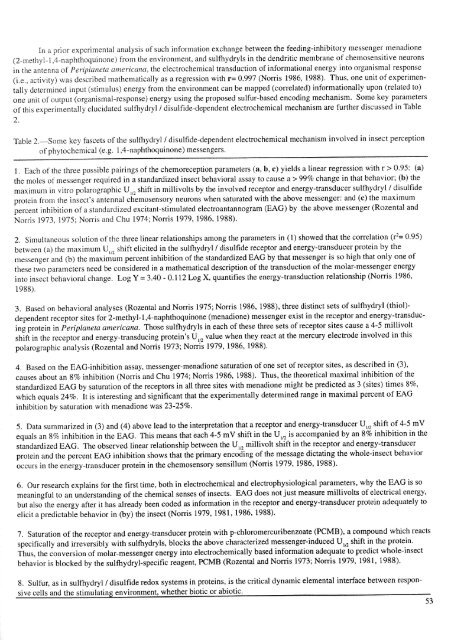View or print this publication - Northern Research Station - USDA ...
View or print this publication - Northern Research Station - USDA ...
View or print this publication - Northern Research Station - USDA ...
You also want an ePaper? Increase the reach of your titles
YUMPU automatically turns print PDFs into web optimized ePapers that Google loves.
Iraa pri<strong>or</strong> experimental analysis of such inf<strong>or</strong>mation exchange between the feeding-inhibit<strong>or</strong>y messenger menadione<br />
(2-methyt-t ,4-naphthoquinone) from the environment, and sulthydryls in the dendritic membrane of chemosensitive neurons<br />
in the antenna of Periplaneta americana, the electrochemical transduction of inf<strong>or</strong>mational energy into <strong>or</strong>ganismal response<br />
(i.e., activity) was described mathematically as a regression with r= 0.997 (N<strong>or</strong>ris 1986, 1988). Thus, one unit of experimentally<br />
determined input (stimulus) energy from the environment can be mapped (c<strong>or</strong>related) inf<strong>or</strong>mationally upon (related to)<br />
one unit of output (<strong>or</strong>ganismal-response) energy using the proposed sulfur-based encoding mechanism. Some key parameters<br />
of <strong>this</strong> experimentally elucidated sulflaydryl / disulfide-dependent electrochemical mechanism are further discussed in Table<br />
2.<br />
Table 2.--Some key fascets of the sulfhydryl / disulfide-dependent electrochemical mechanism involved in insect perception<br />
of phytochemical (e.g. 1,4-naphthoquinone) messengers.<br />
1. Each of the three possible pairings of the chem<strong>or</strong>eception parameters (a, b, e) yields a linear regression with r > 0.95: (a)<br />
the moles of messenger required in a standardized insect behavi<strong>or</strong>al assay to cause a > 99% change in that behavi<strong>or</strong>; (b) the<br />
maximum in vitro polarographic U_/2shift in millivolts by the involved recept<strong>or</strong> and energy-transducer sulflaydryl / disulfide<br />
protein from the insect's antennal chemosens<strong>or</strong>y neurons when saturated with the above messenger: and (e) the maximum<br />
percent inhibition of a standardized excitant-stimulated electroantannogram (EAG) by the above messenger (Rozental and<br />
N<strong>or</strong>ris 1973, 1975; N<strong>or</strong>ris and Chu 1974; N<strong>or</strong>ris 1979, 1986, 1988).<br />
2. Simultaneous solution of the three linear relationships among the parameters in (1) showed that the c<strong>or</strong>relation (rZ= 0.95)<br />
between (a) the maximum U_/2shift elicited in the sulfhydryl / disulfide recept<strong>or</strong> and energy-transducer protein by the<br />
messenger and (b) the maximum percent inhibition of the standardized EAG by that messenger is so high that only one of<br />
these two parameters need be considered in a mathematical description of the transduction of the molar-messenger energy<br />
into insect behavi<strong>or</strong>al change. Log Y - 3.40 - 0.112 Log X, quantifies the energy-transduction relationship (N<strong>or</strong>ris 1986,<br />
11988).<br />
3. Based on behavi<strong>or</strong>al analyses (Rozental and N<strong>or</strong>ris 1975; N<strong>or</strong>ris 1986, 1988), three distinct sets of sulfhydryl (thiol)dependent<br />
recept<strong>or</strong> sites f<strong>or</strong> 2-methyl-1,4-naphthoquinone (menadione) messenger exist in the recept<strong>or</strong> and energy-transducing<br />
protein in Periplaneta americana. Those sulfhydryls in each of these three sets of recept<strong>or</strong> sites cause a 4-5 millivolt<br />
shift in the recept<strong>or</strong> and energy-transducing protein's U_/2value when they react at the mercury electrode involved in <strong>this</strong><br />
polarographic analysis (Rozental and N<strong>or</strong>ris 1973; N<strong>or</strong>ris 1979, 1986, 1988).<br />
4. Based on the EAG-inhibition assay, messenger-menadione saturation of one set of recept<strong>or</strong> sites, as described in (3),<br />
causes about an 8% inhibition (N<strong>or</strong>ris and Chu 1974; N<strong>or</strong>ris 1986, 1988). Thus, the the<strong>or</strong>etical maximal inhibition of the<br />
standardized EAG by saturation of the recept<strong>or</strong>s in all three sites with menadione might be predicted as 3 (sites) times 8%,<br />
which equals 24%. It is interesting and significant that the experimentally determined range in maximal percent of EAG<br />
inhibition by saturation with menadione was 23-25%.<br />
5. Data summarized in (3) and (4) above lead to the interpretation that a recept<strong>or</strong> and energy-transducer Uz/2shift of 4-5 mV<br />
equals an 8% inhibition in the EAG. This means that each 4-5 mV shift in the Uu2 is accompanied by an 8% inhibition in the<br />
standardized EAG. The observed linear relationship between the U_a millivolt shift in the recept<strong>or</strong> and energy-transducer<br />
protein and the percent EAG inhibition shows that the primary encoding of the message dictating the whole-insect behavi<strong>or</strong><br />
occurs in the energy-transducer protein in the chemosens<strong>or</strong>y sensillum (N<strong>or</strong>ris 1979, 1986, 1988).<br />
6. Our research explains f<strong>or</strong> the first time, both in electrochemical and electrophysiological parameters, why the EAG is so<br />
meaningful to an understanding of the chemical senses of insects. EAG does not just measure millivolts of electrical energy,<br />
but also the energy after it has already been coded as inf<strong>or</strong>mation in the recept<strong>or</strong> and energy-transducer protein adequately to<br />
elicit a predictable behavi<strong>or</strong> in (by) the insect (N<strong>or</strong>ris 1979, 1981, 1986, 1988).<br />
7. Saturation of the recept<strong>or</strong> and energy-transducer protein with p-chl<strong>or</strong>omercuribenzoate (PCMB), a compound which reacts<br />
. specifically and irreversibly with sulfhydryls, blocks the above characterized messenger-induced Uu2 shift in the protein.<br />
Thus, the conversion of molar-messenger energy into electrochemically based inf<strong>or</strong>mation adequate to predict whole-insect<br />
behavi<strong>or</strong> is blocked by the sulfhydryl-specific reagent, PCMB (Rozental and N<strong>or</strong>ris 1973; N<strong>or</strong>ris 1979, 1981, t988).<br />
8. Sulfur, as in sulfhydryl / disulfide redox systems in proteins, is the critical dynamic elemental interface between responsive<br />
cells and the stimulating environment, whether biotic <strong>or</strong> abiotic.<br />
53
















